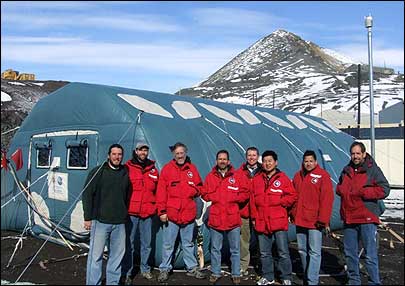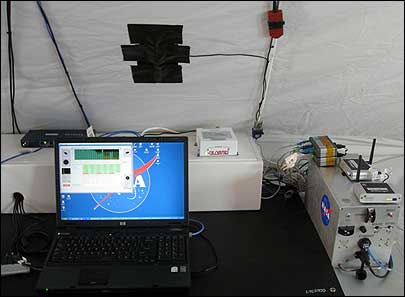Jun 12, 2008At NASA's Johnson Space Center (JSC), researchers are employing RFID technology to bring data home from Antarctica. This project is part of an experiment implemented by NASA, the National Science Foundation (NSF) and Apollo lunar spacesuit makers ILC Dover, to test an inflatable habitat, and to determine whether such a structure might provide a comfortable living space in the Arctic and Antarctica regions, as well as for explorers on the moon or, eventually, on Mars.
NASA astronauts are expected to resume exploration of the moon in 2020, and the organization hopes to be able to provide living space by that time. To test an inflatable habitat that is lightweight and easy to transport, but that can withstand the harsh conditions on another planet, NASA is beginning on Earth—in Antarctica. NASA is testing how well an inflatable habitat would survive in such harsh conditions, and how well it would provide shelter that could support human life inside. As part of that research, it is also testing sensor systems that measure the conditions around and within the structure, as well as the ability to transmit those sensor measurements back to researchers in the United States.

The habitat measures internally at 16 by 24 feet, and was developed by NASA, the NSF and ILC Dover. In January 2008—summertime in Antarctica—the habitat was first inflated and installed near McMurdo Station. At the same time, instrumentation engineers David Scott Hafermalz and Todd Hong installed a sensor system to measure temperature and air pressure, as well as carbon dioxide level, humidity, power consumption and weather conditions. For the temperature and air pressure sensors, researchers are utilizing two RFID systems—one passive, the other active.
Researchers hope to maintain an internal temperature of 55 degrees Fahrenheit (13 degrees Celsius), despite the weather conditions outside. Currently, at the onset of winter, the temperature outside the habitat is about -33 degrees Fahrenheit (56 degrees Celsius) and dropping, with snowdrifts piling up on top. JSC researchers installed temperature sensors within the structure's bladder (air-filled walls), as well as in the interior living space. They also installed two webcams, one of which can be zoomed in to view instrumentation such as a light indicating the instruments are functioning, and to see the screens of a laptop and PC storing data from the sensors. Much of the instrumentation consisted of such off-the-shelf devices as temperature and pressure gauges, Hafermalz says, while others were designed specifically for this purpose.
"We wanted sensors to be deployed independently," Hafermalz says, meaning he and Hong attached RFID tags in enclosed pockets on the habitat wall, connected to sensors after the habitat was inflated in Antarctica, while others were imbedded in the structure as it was being manufactured. "And we were looking for things that were robust enough to handle the packing and shipping, and that would be low-maintenance."
Researchers required equipment that would make it possible for them to monitor conditions in the structure at Johnson Space Center without calling upon support from employees stationed at the McMurdo base, who are busy with other responsibilities. "We wanted their support to be minimal," Hafermalz says, "so we needed something that would be maintenance-free." All these needs, he adds, pointed to RFID technology.
The tags capture that temperature, and to save battery life, they transmit it to the interrogator's antenna only once every 15 minutes. The interrogator is cabled to the laptop, which then sends the information back to the United States via communication satellite—first to NASA's Denver office, where the Internet-based data is then sent to Johnson Space Center. The system utilizes Visible Assets' hardware, including tags, antenna and RFID reader, as well as software to translate data from that interrogator.

In a separate system, approximately eight passive Honeywell RFID tags transmit at 434 MHz using a proprietary air-interface protocol. The tags are embedded in the walls and wired to sensors measuring temperature and air pressure within the wall. A dedicated interrogator antenna for each tag transmits to a multiplexer, which sends the data at a rate of about five times per minute to a single interrogator, also cabled to the laptop computer.
By using the multiplexer, researchers are able to avoid backscatter from multiple tags received by one interrogator that would be unable to properly interpret those multiple transmissions. Honeywell provided the software that identifies the antenna and tag number, and translates sensor data. As with the Visible Assets solution, Hong explains, the Honeywell system data is transmitted via satellite. With both systems, Hafermalz says, researchers have been able to bring up and examine data in real time, with a delay of a few seconds.
So far, Hafermalz says of the inflatable structure, "It's holding up pretty well—there is a lot of snow drift on top, but it hasn't affected the internal structure thus far." When it came to the RFID system, Hong says, "One of our concerns was the availability of power. They had some shutdowns of power, which corrupted some of our files." By having a camera system to view the computer and sensors, however, Hong and Hafermalz were able to conduct troubleshooting. Occasionally, the McMurdo staff has had to manually press the generator's reset button. Since then, Hong says, the team has added an uninterruptible power supply (UPS) system.
The researchers are not yet ready to declare either the RFID systems or the structure itself a success. "We are still in the early phases of data analysis," Hafermalz says. "Time will tell whether the structure holds up over a year. We have a high degree of confidence that, ultimately, the habitat and the sensor systems used to monitor the structure will prove successful." In December 2008, the structure and sensors may be further tested at that location, or the structure may be removed.

